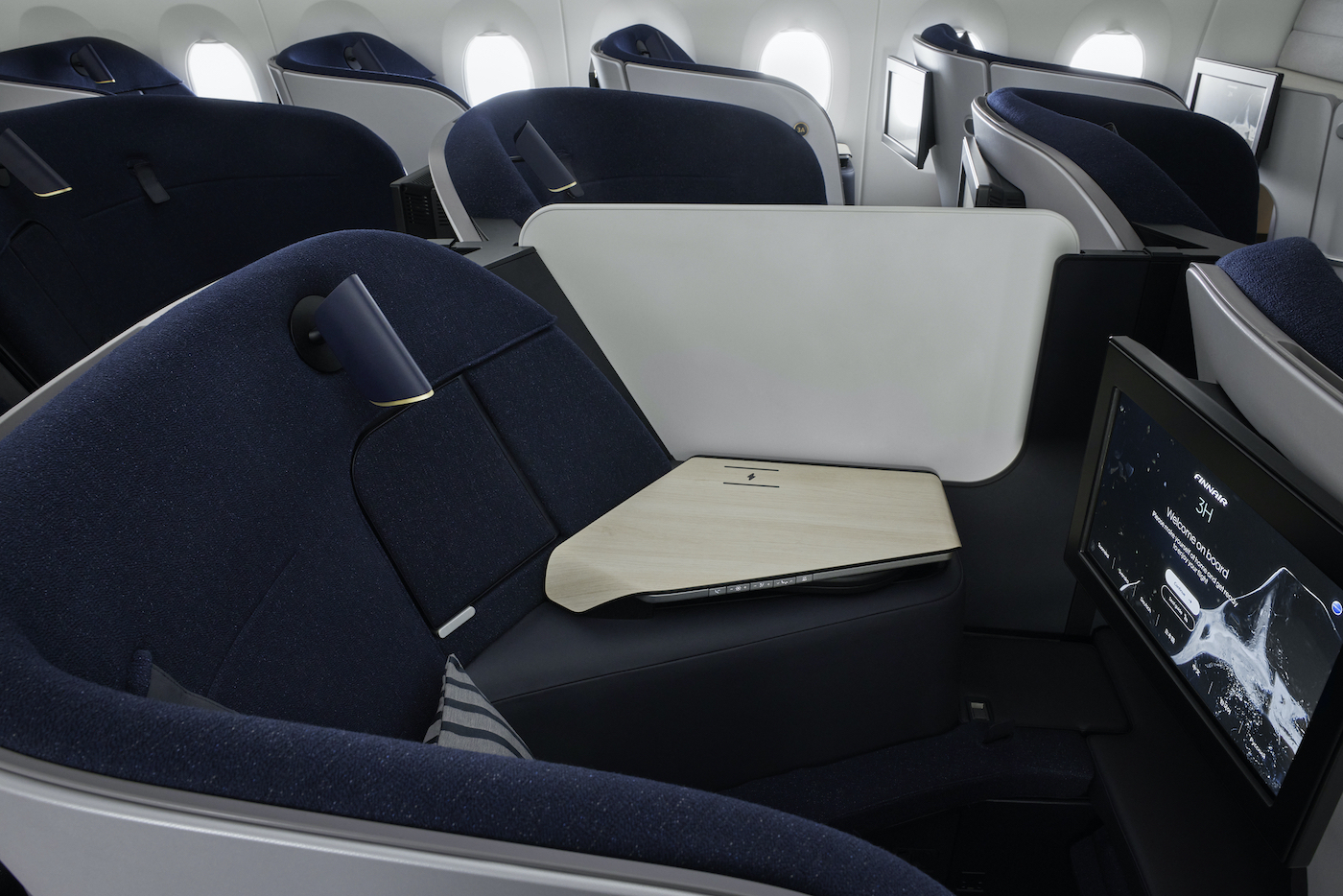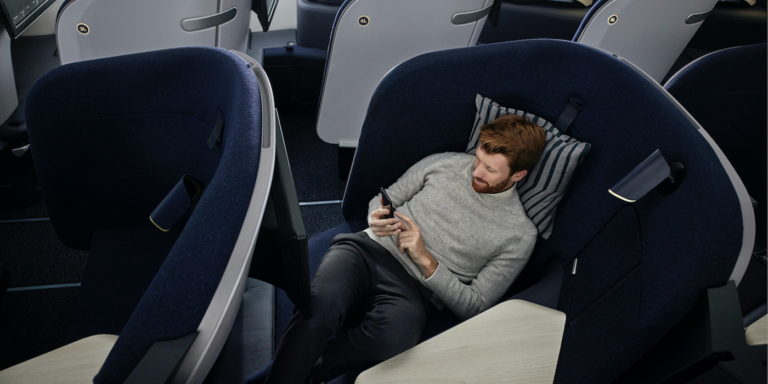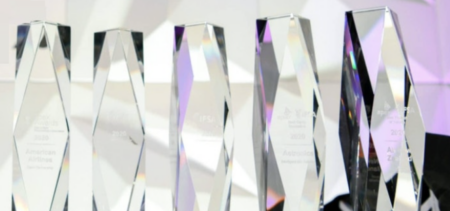Aircraft Interiors International visited Helsinki this week to view Finnair’s premium economy class product – a new class of travel for the airline. However, a trip to a maintenance hangar at Vantaa Airport yielded much more, for the A350 within was fitted with the airline’s new long-haul cabin designs for every class. As surprises go, this was quite something, as are the cabins – especially business class, which has been a top-secret labour of love for the past four years.
Boarding this aircraft gave a first look at the results of Finnair’s €200 million (US$229m) project to update its long-haul cabins, with the new designs due to be rolled out across the airline’s entire fleet of A330s and A350s over the next two years. The first routes for the new interiors will be announced on 1 March, 2022, likely beginning with Japan.
We have some great interviews with key members of the Finnair team, plus some detail photos of the new cabins. Keep an eye out for our March issue for the full story behind the designs, and on our website for exclusive images. For now, here are the initial details…
AirLounge: a new seat, a new experience
The updated long-haul business class cabins have a 1-2-1 layout, but that is where any similarity with Finnair’s current A350 and A330 cabins end. The colour scheme is darker and warmer, and the seat is a radical departure from not just the outgoing business class, but any business class in the skies today. The airline has taken a new direction, with a seat that feels less like a feat of engineering and more like a piece of furniture.
Unlike many traditional aircraft seats – such as Finnair’s current Zodiac Cirrus III model – the AirLounge takes inspiration from lounge furniture and is designed to maximise customer comfort, space, and freedom to move during a long-haul flight.

There are few hard surfaces or straight lines in the AirLounge: just soft, textile-covered curves. And just as few people buy home seating with complex electrical systems, the AirLounge does not use actuators and recline mechanisms to achieve passenger comfort. The generous width and gentle curve of the fixed seat-shell enables occupants to move between a wide variety of sitting and sleeping positions – and as many designers have said, the most comfortable position is your next position.
Creating the fully flat bed merely involves lifting up an infill panel, to create a wide, flat sleeping surface. For taller passengers (such as I), a semi-foetal sleeping position works best in the space. Overall the seat is a free space, the occupant’s position within being theirs to decide: not just choosing between pre-defined options. Perch, slouch, recline, loaf – the choice is entirely yours, not dictated by the seat’s range of movement.
As David Kondo, Finnair’s head of customer experience product design said at the reveal, “By doing away with complicated seat mechanisms and using 3D curved shells, we’re able to provide a larger flexible living space. This allows customers to move more freely and take up different positions which traditional aircraft seats do not allow.” Indeed Kondo likens the seat to a nest.
Kondo joined Finnair in 2019 and may be familiar to many of you from his previous positions as Qatar Airways’ product research & strategy specialist, and product roles at Jetstar Airways and Virgin Australia. You would struggle to find someone with a greater passion for aviation than Kondo, and we will share his insights in the March 2022 issue of Aircraft Interiors International.

Finnair is the launch customer of the AirLounge seat, a concept originally conceived by the PriestmanGoode studio, which Collins Aerospace has further developed into a commercial reality. AirLounge was then given some Finnair flair, with the airline’s in-house design team, led by Kondo, adding their own customisation and final design execution requirements, in partnership with design partner, Tangerine.
Finnair considered fitting a door to the seat – a growing trend in business class suites, but felt the high shell of the seat provides sufficient privacy. Indeed a door would detract from the organic, residential feel of the cabin. There is a privacy option for the centre doubles though, with a double-tap of a button activating the divider panel.
It is interesting that a low-tech approach feels so innovative, but while many airlines talk about a residential feel in the cabin, the AirLounge is the closest I have seen to an airline really achieving it. In my view, perhaps the closest was TAM’s Boeing 777-300ER first-class cabin from 2013.
There are some conventional comforts too, such as a customised lamp, various useful TTL-certified storage options, USB-A, USB-C, PC power, a flexible table incorporating a wireless mobile charging panel, and an 18in IFE display (2in larger than currently) with a GUI that was developed in-house.

The darker colour scheme of the business cabin feels much warmer than the current white and grey palette and draws inspiration from Finnair’s lounges in the non-Schengen area at Helsinki Airport, unveiled in 2019. The thick, dark textiles really add to the feeling of softness and quality and that warmth may appeal to a broader spectrum of passengers.
While many flyers are drawn to the Finnish flag carrier due to its time-efficient short northern route connecting Asia and Europe, the new cabin gives the airline a further advantage in attracting customers.

Finnish fine dining
Business class customers will enjoy renewed meal and beverage offerings, including an up to six-course meal in a modern bistro-style and another lighter meal.
The Finnish home feel is carried over into the serviceware, with contemporary chinaware from Finnish design house, Iittala. The Kuulas dining collection is designed by Harri Koskinen specifically for inflight service and is almost 20% lighter than Finnair’s previous tableware. The range includes plates, bowls, cups, tumblers, wine glasses and cutlery.

Aft from business class is the boarding area, with the galley concealed behind wood panelling and a new refreshment area opposite. The monuments were developed with AIM Altitude to achieve a warm, welcoming feel for all passengers. There is even a glass-fronted cabinet at eye level, to display the airline’s iconic Iitala Ultima Thule glasses – a design now more than 50 years old.

And beyond that area is something else rather interesting…
Premium economy: another new seat!
The A350’s dedicated 26-seat cabin (though with room to expand) is a new travel class for Finnair, and a potentially significant one. As Ole Orvér, Finnair’s chief commercial officer says, “The trend for premium travel has significantly accelerated during the pandemic, so we are confident our new premium economy travel class will prove very popular with customers looking for an upgraded experience from economy.”

Finnair is the launch customer of HAECO’s Vector Premium seat, which will also be rolled out across the A330 fleet. The seat features memory foam cushions, a deep 8in recline, waterfall leg rest and six-way headrest. We tried it, and at full recline with legrest deployed, it really is a comfortable place to be. It won’t lure business class travellers to make a fare saving, but with approximately 50% more space than the economy class seats, it is a genuine upgrade from the basic offering.
A particularly useful feature is the large seatback stowage space that can accommodate a laptop – useful for TTL, so passengers don’t have to stow them overhead. A smaller compartment can hold personal items, with a lid to keep them in place.
Other features include a large, sturdy single-leaf meal tray for work and dining, individual reading lights, universal PC power and USB-A ports and a 13in IFE display.

Finnair has a good relationship with HAECO, as the company also provides its heavy maintenance services and is handling its cabin refits. The seat customisation work was again a collaboration between Kondo’s team and Tangerine.
Premium economy customers can enjoy two meal services, including a three-course meal served on Iittala chinaware and a light meal service just before landing.
The amenities are again designed with Marimekko, including a neck pillow and woven blanket. Top tip: Of all the inflight items in the new long-haul cabins, the premium economy blanket is perhaps the most worth taking home (with permission, of course).

Finnair has also refreshed its long-haul economy cabins, with the lightweight Zodiac Z300 seats finished with new pale grey seat covers, USB-A & C connectivity and upgraded IFE with an updated user interface.

All in, with two major seat launches, the new Finnair long-haul cabins are something special. The cabins will help lure passengers to Finnair, as will the airline’s route plans: in summer 2022, Finnair intends to serve nearly 100 destinations in Europe, Asia and the US, including new long-haul routes to Busan, in South Korea, Tokyo Haneda in Japan as well as Dallas and Seattle in the USA.
2022 also marks Finnair’s centenary. While the past two years have been a low point for aviation, with the new cabins the airline is positioning itself for a strong recovery – and a strong century ahead.





